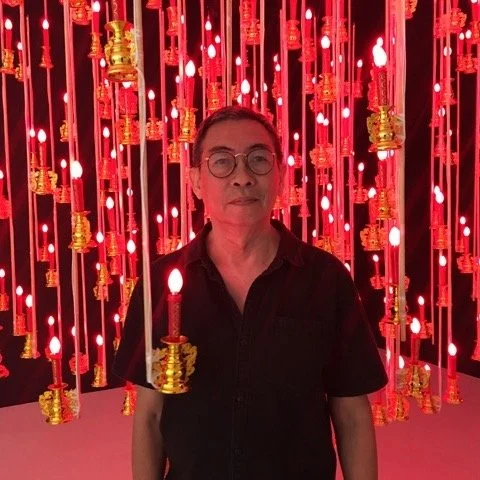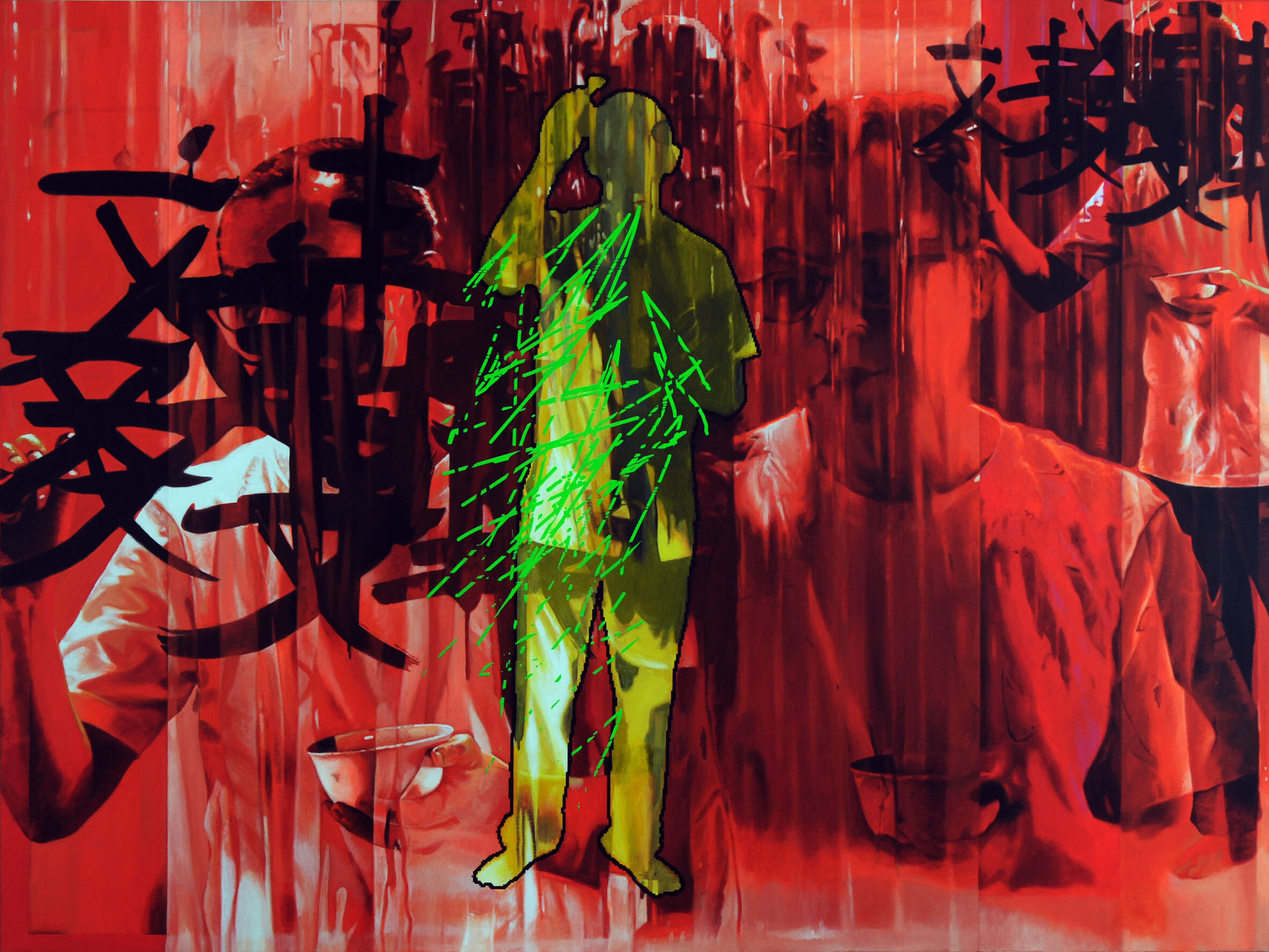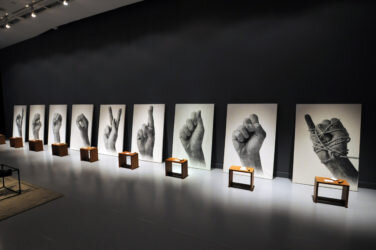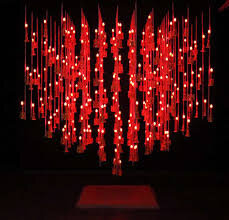Courtesy of the artist and Tyler Rollins Fine Art, New York
THE CREATIVE PROCESS
And then I think after the fall of Suharto in 1998, art historians and commentators have said that your body of works began to turn inward, and your portrait of yourself began to make an appearance in your works, for example, in My Body as a Field (2002) and Open Your Mouth (2001). What led to your turn inwards and your examining of your personal history as a Chinese minority in Indonesia?
FX HARSONO
After 1998, the political situation changed totally. We called it Reformasi (reformation). The culture also changed. A lot of things changed. During the New Order of Suharto, we only had 4 TV stations. One was government-controlled, and the other three were controlled by Suharto and his sons and daughters. After 1998, suddenly a lot more TV stations were developed, so people had more freedom to speak, and to criticise the government. The media or news can do so. I made a work about the transition, called Open Your Mouth. Everyone can speak, why won’t you open your mouth, but I realised that even with the freedom to speak, and lots of people are criticising the government, but the talk and criticism is no good, it had no value.
THE CREATIVE PROCESS
Is that why all the mouths in the work are all white spaces?
HARSONO
It means there is no content in the speech.
THE CREATIVE PROCESS
Maybe they don’t even know what to say?
HARSONO
Yes. Blank Spot on my TV (2003) is another work I made. Every evening when I came back from the office, I saw the news on TV. Very interesting, and everybody can criticise, so I documented what’s on TV with my camera. I selected some and presented it as an artwork. I placed the photograph of the TV as a white spot on the TV, so that it looked as if all the activists have disappeared.
THE CREATIVE PROCESS
It was also at this time that you came across some of the photographs your father took of the victims of...
HARSONO
That’s later. 2009. Before that, I started to question myself. What do I want to do now that the situation has changed so much that people have the freedom to criticise the government?
During this time, I realised that I’m Chinese and a minority in Indonesia, and have experienced a lot of discrimination. I’ve been focussing so much on the government and its acts of suppression, but I’ve personally experienced a lot of discrimination, so I felt that I wanted to talk about being Chinese.
THE CREATIVE PROCESS
You have a Chinese name?
HARSONO
When I was 18 years old in 1996, I had to choose between being an Indonesian citizen or being a Chinese citizen. In Indonesia, a baby born Chinese isn’t automatically Indonesian. When he or she reaches 18, he or she has to choose. When I chose Indonesian citizenship, the new rule after 1965 was that you had to choose an Indonesian name. Prior to 1998, the school was prohibited from teaching Chinese as a language. Chinese people couldn’t practice Chinese rituals or culture. This changed completely in 1998. Schools could teach Mandarin. Chinese New Year became a holiday and Chinese people could celebrate it. They could go to the temple to pray. I realised I had a prior Chinese name. I started to learn again how to write my Chinese name and I made a performance using my Chinese name.
THE CREATIVE PROCESS
What is that name?
HARSONO
Ho Fong Wen (in Mandarin). Or Oh Hong Bun (in Hokkien). I changed it to Harsono. FX stands for Francis Xavier.
THE CREATIVE PROCESS
Do you know what your Chinese name means?
HARSONO
Fong means harvest. Wen means literature. So it means harvest of arts, culture and literature.
THE CREATIVE PROCESS
So you were always meant to be in the arts.
HARSONO
(laughing) Yes, it does look like I was born to be an artist.
THE CREATIVE PROCESS
Writing in the Rain (2012) then becomes a very powerful work, because there you are consistently continuously writing your name in Chinese using black ink. And then it all gets away by rain. What was in your mind when you were performing that work?
HARSONO
I want to say I have a Chinese name, and I want to show that in the video performance. I write it again and again. But the rain comes and washes all the text away from the glass. It means for me that even though I have a Chinese name, for 32 years I used my new name. People know me as Harsono. I exist as Harsono. I’m thinking my Chinese name is unnecessary and not remembered.
THE CREATIVE PROCESS
What’s interesting for me experiencing watching the video of Writing in the Rain and then encountering a different work of yours Pilgrimage into History (2013) where you made rubbings of Chinese names from a mass gravesite. There’s a congruence between the two works. They echo each other, and it’s a troubling echo, a sad one. This rewriting of the names is something you keep coming back to. Different works you’ve produced have this aspect of the writing of the Chinese names. What draws you to this, that you keep coming back to it again and again?
HARSONO
The work you mention Pilgrimage to History is a textile rubbing from Chinese characters engraved on tombstones. The work started from my research into the massacre of Chinese people during the 1960s. I started this research because of my father’s photographs. He started to make documentation about the killings of the Chinese people in my hometown. I also visited some mass graves in other places, and when I saw them, there were tombstones which had Chinese names of the people who were buried in these mass graves. I thought about how I could make a work from this. I could take a photograph, but somehow it’s just a photograph. I wanted something that was part of this mass grave. It then occurred to me I could make a textile rubbing, it would be a trace of the original, and it would be part of the gravestone. When I started making the rubbings, I realised it was also my pilgrimage. It’s the way I make a pilgrimage to the victims. So I made a documentation of my performance and also as part of my journey of pilgrimage.
THE CREATIVE PROCESS
So, the writing of your personal name becomes part of the collective identity of being Chinese Indonesian, and in the larger fabric of Indonesia, it’s very much tied to this erasure by the Indonesian Government of the Chinese identity.
HARSONO
Yes. If someone has a baby and gives it a name, it’s not just a name, it’s a hope and a prayer from the parent to the baby. A name is a prayer – the parent is saying I hope that you will become a good person, or a rich person, or a wise person. So when the government forces a person to change his or her name, it’s erasing this hope and prayer of the parents, and replacing it with a new hope and prayer. A hope from the government, not the parent.
THE CREATIVE PROCESS
I like that. A beautiful way to say it. That your name is a prayer. So how does it feel then to have your work shown in Times Square NY on a major digital billboard where you’re writing your name in front of all these New York lights and glamour?
HARSONO
I was fairly shocked at the time. It’s amazing. Suddenly my video wasn’t showing on just one LED panel, but on sixteen panels. The feeling was amazing, very heavy for me.
THE CREATIVE PROCESS
What has been the reaction, or the reception, that’s filtered back to you?
HARSONO
On social media, lots of people have said it’s amazing.
Voice of America, in my interview with them, also said I’m the only Indonesian artist who has shown this work on Times Square.
THE CREATIVE PROCESS
I want to recircle back to our theme of education, since this is an educational initiative at The Creative Process. I want to talk about the role of art in education. I understand that you’re a teacher as well. How do you see the future of art in education? How can we incorporate art in education, in a way that isn’t stratified or top down?
HARSONO
If someone understands art, the effect is not just concerning the art, it’s a feeling. The mental and the ethical aspects become more cultured, and more socially aware. Art as education provides a way to help us respect others, respect their culture, their humanity.
THE CREATIVE PROCESS
It connects us to the human condition, doesn’t it? It’s a universal thing and it’s democratic.
HARSONO
Yes. Indonesia is very diverse, and it’s very important that people understand it’s not a monoculture but a multi culture. We meet and interact with a lot of the other ethnicities and we know that they have a different language and culture. We must respect this. Art is very important for educating, not how to become an artist, but how to understand and learn about others.
THE CREATIVE PROCESS
Thank you so much, Pak FX, for your time and your body of work as a witness to multiple decades of Indonesian history. Your work is a monument to not forgetting the sacrifices of people and victims in the past.
HARSONO
My pleasure.
Photo courtesy of Sullivan + Strumpf and the artist



























